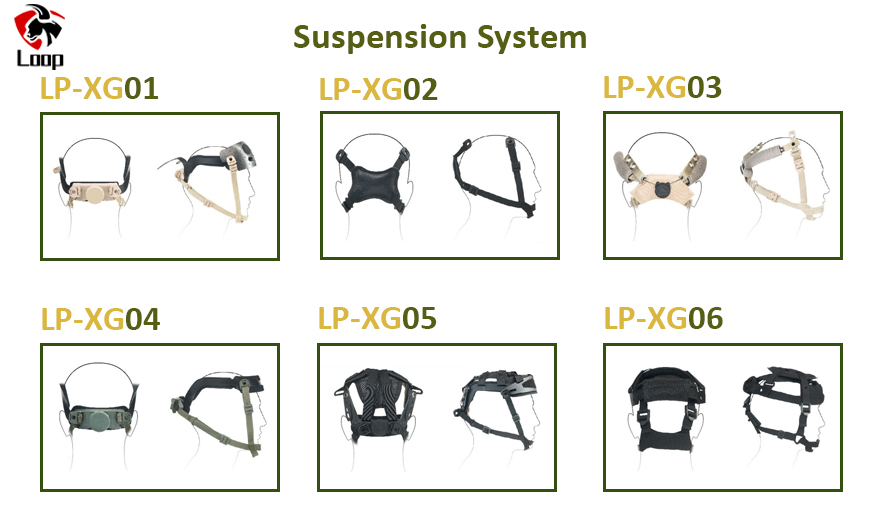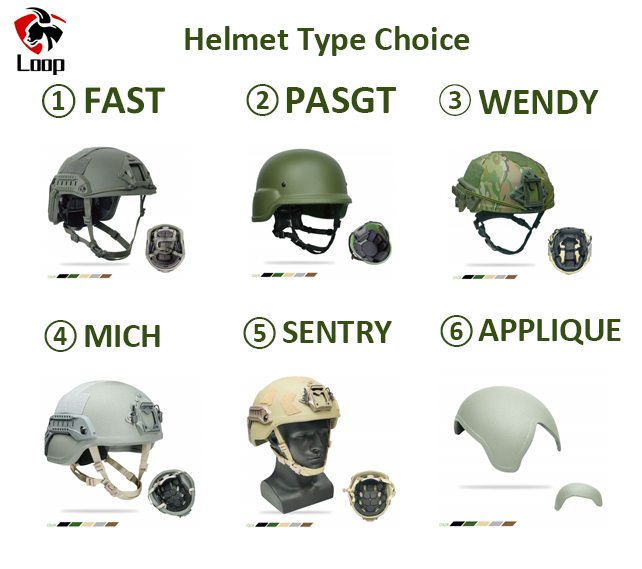Views: 0 Author: Site Editor Publish Time: 2025-09-05 Origin: Site
In modern tactical equipment and protective systems, the tactical helmet is essential for personnel operating in high-risk environments. Beyond the ballistic shell, the component that truly shapes comfort, safety, and performance is the helmet suspension system. It is not just a “retention kit”; it is the core that governs comfort, protection, stability, and tactical effectiveness.
The helmet suspension system is the internal structure that secures, cushions, and supports the wearer’s head. It commonly includes:
Headband and adjusters to conform closely to the wearer’s head shape;
Cushion pads/liners to absorb impact and reduce head injury;
Retention straps to prevent the helmet from shifting during dynamic movement;
Dial fit or quick-release mechanisms to adapt to different mission needs.
Historical evolution: Early steel helmets used leather or web suspensions with limited function—little energy attenuation and poor long-term comfort. With advances in materials and ergonomics, modern systems integrate multi-layer foams, air/energy-absorbing modules, and modular pad layouts to disperse impact while maintaining stability and comfort. Many high-end tactical helmets now allow quick swapping of suspension configurations to suit desert, jungle, or urban operations.

If a helmet focuses only on the protective outer shell and neglects the internal suspension/liner design, the following risks may arise:
During high-intensity movement, running, or under weapon recoil, the helmet may shift, tilt, or even come off — causing the ballistic shell’s coverage point to move off target, thereby losing effective protection.
Without proper padding or cushioning, the acceleration/deceleration from impacts or blast shockwaves will be transferred directly to the skull and brain tissue, increasing the risk of traumatic brain injury (TBI) or other serious head trauma.
Wearing a helmet for long periods without adequate support can lead to severe neck fatigue, shoulder and neck soreness, impaired blood circulation, and reduced attention — all of which degrade tactical performance and increase the likelihood of errors.
If the padding is not breathable or lacks moisture-wickling and ventilation design, prolonged wear under hot or intense conditions can cause overheating, excessive sweating, dehydration — creating additional risks for wearer safety and performance.
1) Impact attenuation and shock mitigation. Even when a shell defeats fragments or a blunt strike, energy still transfers toward the head. Without effective absorption and distribution by the suspension, concussion can still occur.
2) Stability and fit. During sprinting, jumping, or CQB, the helmet must move with the head. A reliable suspension prevents wobble that obstructs vision or disrupts aiming.
3) Comfort. Tactical helmets often weigh over 1 kg. Poor suspension design leads to pressure hot-spots and neck fatigue over long missions. Modern systems spread load evenly and enhance breathability to reduce strain.
4) Compatibility. Night vision, comms headsets, goggles, and cameras are commonplace. A high-performance suspension carries added mass while keeping balance, avoiding side-load discomfort.
Survivability. Even if the shell stops a threat, inadequate energy management can still cause serious brain injury. Suspension is a hidden but decisive safety layer.
Operational efficiency. Stable, comfortable fit lets operators focus on observation and aiming rather than readjusting the helmet—crucial in special operations and counter-terror missions.
Environmental adaptability. Different suspensions address heat, humidity, or cold to match desert, jungle, and urban demands.
Psychological advantage. Secure, comfortable gear builds confidence and reduces distraction under stress.
Compared with older web-style suspensions, modern systems deliver a step-change in performance. Traditional webbing kept the helmet on the head but provided minimal impact attenuation. Discomfort increased with time, and stability suffered during aggressive movement. In contrast, modern suspensions employ high-density foams such as EPP/EVA, multi-point adjustments, and optimized pad layouts that effectively disperse impact, lock in a firm fit, and markedly improve long-wear comfort. Just as important, they provide far better accessory compatibility for NVGs and comms, meeting today’s multi-role mission requirements. In short, upgrading the suspension elevates not only comfort but also protection and tactical efficiency.
Military. FAST, ACH, and MICH families commonly integrate high-performance suspensions for modern combat needs.
SWAT/Law Enforcement. Long wear times during counter-terror and public-order tasks demand superior comfort and stability.
Private Security. Continuous protection and a steady platform for patrols and rapid response.
Training & Exercises. Better shock reduction and comfort reduce fatigue and improve training continuity.
Energy-absorbing materials: Look for EPP/EVA or equivalent high-performance foams and proven pad architectures.
Adjustment: Dial-fit systems and multi-point strap tuning to accommodate diverse head shapes.
Breathability: Moisture-wicking textiles and vented pad layouts for hot environments.
Compatibility: Seamless pairing with NVGs, comms headsets, goggles, and masks.
Modularity & maintenance: Quick replacement of pads/liners for hygiene and mission-specific setups.
Recommended next steps:
Explore FAST-style ballistic helmets with modular suspensions.
Compare replacement suspension kits for retrofits/refresh.
Pair with NVG mounts and comms headsets to validate fit and balance.

The helmet shell is the shield; the suspension is the bridge between protection and the human body. A truly capable tactical helmet depends not only on a strong shell but also on a scientifically designed suspension. Helmet suspension enhances comfort and directly determines protective outcomes and mission performance.
If you are considering tactical helmets, ballistic helmets, suspension upgrade kits, Or other Loop Circle equipment, contact our team for solutions tailored to your mission profile and a professional quotation.